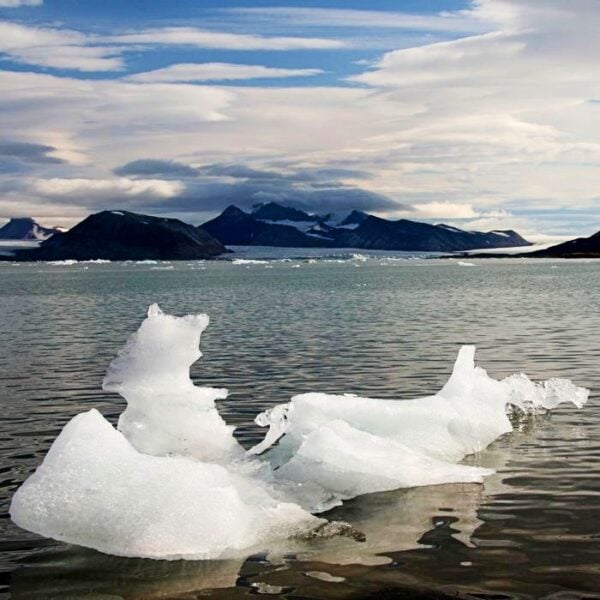The world’s mountain glaciers face a troubling future even if humanity manages to reverse global warming, according to a groundbreaking new study that looks centuries ahead. Researchers discovered that once glaciers begin disappearing, they cannot easily be restored—even if temperatures return to safer levels—revealing a permanent climate legacy our descendants will inherit long after we’re gone.
The research, published today in Nature Climate Change, presents the first global projections of glacier change through the year 2500, offering an unprecedented long-term view of how these crucial ice formations respond to climate “overshoots,” where global temperatures temporarily exceed the 1.5°C Paris Agreement threshold before cooling back down.
If the planet warms to 3°C before subsequently cooling to 1.5°C, glaciers would lose up to 16% more of their mass compared to scenarios where temperatures never exceed the 1.5°C target. This additional melt would contribute significantly to sea level rise and disrupt water supplies in vulnerable regions.
The Long Shadow of Temporary Warming
“Current climate policies are putting the Earth on a path close to 3°C. It’s clear that such a world is far worse for glaciers than one where the 1.5°C limit is held,” said Dr. Fabien Maussion, Associate Professor in Polar Environmental Change at the University of Bristol and corresponding author of the study.
The question of whether glaciers can recover after an overshoot has significant implications for future generations. Unfortunately, the answer appears to be disheartening.
“We aimed to discover whether glaciers can recover if the planet cools again. It’s a question many people ask—will glaciers regrow in our lifetime, or that of our children? Our findings indicate sadly not,” Maussion added.
This research comes as Earth experienced its hottest year on record in 2024, with global temperatures temporarily exceeding the 1.5°C threshold for the first time over a full calendar year.
Not All Glaciers Respond Equally
The study found that different glaciers respond to warming and cooling at varying rates, with some potentially recovering faster than others. The researchers identified key patterns in how glaciers worldwide would behave in overshoot scenarios:
- Large polar glaciers would take many centuries, if not millennia, to recover from a 3°C overshoot
- Smaller mountain glaciers in regions like the Alps, Himalaya, and Tropical Andes could potentially recover by 2500—but not within the lifetimes of the next several generations
- Even after temperatures return to 1.5°C, glaciers would still lose 11% more mass by 2500 compared to scenarios where temperatures never exceeded that threshold
- The additional melting from an overshoot would contribute to greater sea-level rise, affecting coastal communities worldwide
‘Trough Water’: A New Climate Challenge
The study introduces a novel concept called “trough water,” which describes what happens when glaciers begin to regrow after an overshoot. When glaciers expand, they start storing water as ice again, reducing water flow downstream—essentially the opposite of the well-documented “peak water” phenomenon that occurs during initial glacier melting.
“If glaciers regrow, they start storing water again as ice – and that means less water flows downstream. We call this effect ‘trough water’, in contrast to peak water,” explained lead author Dr. Lilian Schuster from the University of Innsbruck. “We found that roughly half of the basins we studied will experience some form of trough water beyond 2100.”
This could create unexpected challenges for water management in glacier-fed regions, particularly during dry seasons when meltwater is crucial for agriculture, hydropower, and drinking water supplies.
What makes these findings particularly sobering? Nearly half of the world’s glaciated river basins would experience reduced water flow for decades to centuries after peak warming, even as temperatures fall back to safer levels.
The Ticking Clock
To conduct the study, researchers used pioneering open-source glacier models developed at the University of Bristol and partner institutions, combined with climate projections from the University of Bern in Switzerland. Their simulations extended far beyond typical climate projections, which usually end around 2100.
The study considered a scenario where global temperatures rise to 3.0°C by around 2150 before falling back to 1.5°C by 2300 and stabilizing thereafter. This path represents a future where humanity delays serious climate action but eventually deploys negative emission technologies like carbon capture to bring temperatures back down.
“Overshooting 1.5°C, even temporarily, locks in glacier loss for centuries,” Maussion warned. “Our study shows that much of this damage cannot simply be undone – even if temperatures later return to safer levels. The longer we delay emissions cuts, the more we burden future generations with irreversible change.”
As world leaders debate the pace of climate action and the feasibility of remaining below the 1.5°C threshold, this research provides compelling evidence that temporary overshoots carry permanent consequences. Even if we eventually cool the planet through technological interventions, the glaciers our ancestors revered and relied upon will bear the scars of our decisions for centuries to come.
If our reporting has informed or inspired you, please consider making a donation. Every contribution, no matter the size, empowers us to continue delivering accurate, engaging, and trustworthy science and medical news. Independent journalism requires time, effort, and resources—your support ensures we can keep uncovering the stories that matter most to you.
Join us in making knowledge accessible and impactful. Thank you for standing with us!

